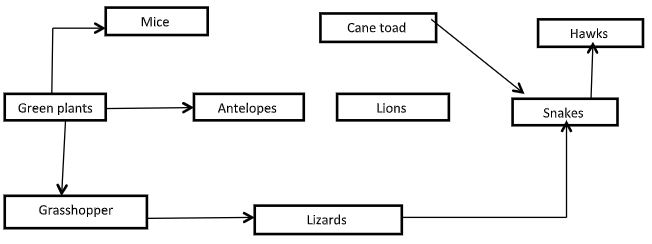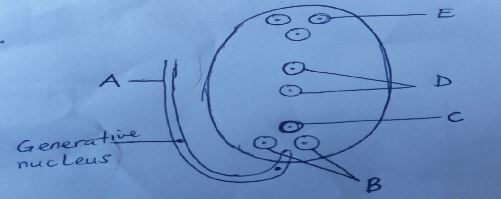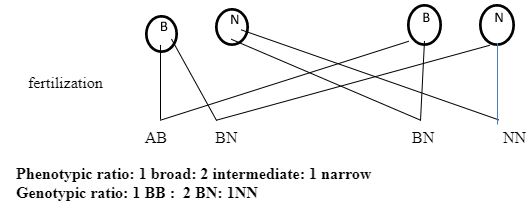Questions
INSTRUCTIONS TO CANDIDATES
- This paper consists of two sections A and B.
- Answer All the questions in Section A in the spaces provided
- In section B answer question 6. (compulsory) and either question 7 or 8 in the spaces provided after question &.
- Candidates should answer the questions in English.
SECTION A( 40 MARKS)
- The diagrams below represents two plants cell A and B placed in two different solutions. Study the diagrams and answer questions that follow.
- Identify the nature of solution into which each cell was placed. (2mks)
A
B - Name the physiological process responsible for the observed results. (1mk)
- Give the correct biological term used to describe cell A. (1mk)
- Describe what would happen if a red blood cell was placed in the solution in which cell B was placed. (2mks)
- Explain why freshwater amoeba do not burst when placed in distilled water. (2mks)
- Explain the fate of glucose after assimilation. (2mks)
- Identify the nature of solution into which each cell was placed. (2mks)
-
- Distinguish between the terms homodont and heterodont. (2mks)
- What is the function of carnassial teeth? (1mk)
- The diagram below represents the lower jaw of a mammal.
- Name the mode of nutrition of the mammal whose jaw is shown above. (1mk)
- State one structural and one functional differences between the teeth labeled J and L. (2mks)
- Name the toothless gap labeled K. (1mk)
- State the function of the gap. (1mk)
- Name the substance that is responsible for hardening of teeth. (1mk)
- What do you understand by the term ‘dental formula’. (1mk)
- The diagram below represents a food web in a terrestrial ecosystem.
- Which organism has the highest number of preys? (1mk)
- Construct food chains with snakes as tertiary consumers. (2mks)
- State the trophic level occupied by hawks in the food chains constructed in (b) above (1mk)
- Describe how capture-recapture method can be used in estimating the population of fishes in a lake. (4mks)
- Name the process through which:
- Producers convert chemical energy into heat energy lost to the environment. (1mk)
- Living organisms convert chemical energy into heat energy lost to the environments. (1mk)
- The figure below shows the embryo sac before fertilization.
- Identify the structures labeled A and B (2MKS)
- Identify the structures labeled in the diagram that will develop into the following after fertilization.
- Embryo (1mks)
- Endosperm (1mk)
- State the ploidy of each of the following nuclei after fertilization
- C (1mk)
- D (1mk)
- Briefly outline the process of ‘double fertilization’ in flowering plants. (2mks)
- Name two substances which are found in the intercellular air spaces in a green leaf during a hot sunny day. (2mks)
- In an investigation, snapdragon plants with broad leaves (B) were crossed with narrow leaves (N). The F1 progeny had intermediate leaf breadth.
- Give a reason for intermediate leaf breadth in F1 generation (1mk)
- If the plants in the F1 Generation were selfed, state the genotypic and phonotypic ratio of the F2 generation. (show your working) (5mks)
- Hemophilia is more common in males than females. Explain this phenomenon. (2mks)
- Explain why an under dose insecticide spraying of mosquitoes may cause a serious problem on this mode of killing mosquitoes using the same spray in future. (2mks)
SECTION B(40 MARKS)
Answer question 6(compulsory) and either 6 or 7 in the spaces provided.
- Two sets of a pea seeds were germinated, set A was placed in normal day light conditions in the laboratory which set B was placed in a dark cupboard. Starting a few days later the shoots lengths were measured twice daily and their mean length recorded as shown in the table below.
Time in hours 0 12 24 36 48 60 72 84 Set A (length (mm) 12 14 20 23 28 31 47 54 Set B length (mm) 17 23 28 35 48 62 80 94 - Using suitable scale draw the graphs of the mean lengths in set A and B against time (7mks)
- From the graph, state the man shoot length of each set of seedling at the 66th hour. (2mks)
- Account for the difference of curve B and A. (3mks)
- Explain what would happen to set up B if it were allowed to continue to grow under conditions of darkness. (4mks)
- State 3 external conditions which should be constant for both set ups. (3mks)
- Why is oxygen important in the process of active transport? (1mk)
-
- state five difference between aerobic and anaerobic respiration. (5mks)
- Discuss the application of anaerobic respiration in industry and at home. (15mks)
-
- state two functions of the mammalian skin. (2mks)
- Describe the structure and function of the mammalian skin. (8mks)
Marking Scheme
- The diagrams below represents two plants cell A and B placed in two different solutions. Study the diagrams and answer questions that follow.
- Identify the nature of solution into which each cell was placed. (2mks)
- Hypotonic/highly concentrated solution
- Hypotonic/ lowly concentrated solution
- Name the physiological process responsible for the observed results. (1mk)
- Osmosis
- Give the correct biological term used to describe cell A. (1mk)
- Plasmolysis; rej plasmolysed
- Describe what would happen if a red blood cell was placed in the solution in which cell B was placed. (2mks)
- It will gain water by osmosis, swell and eventually burst.
- Explain why freshwater amoeba do not burst when placed in distilled water. (2mks)
- Form contractile vacuoles; which get rid of excess water.
- Explain the fate of glucose after assimilation. (2mks)
- Oxidized to produce energy or converted to glycogen for storage.
- Identify the nature of solution into which each cell was placed. (2mks)
-
- Distinguish between the terms homodont and heterodont. (2mks)
- Homodont- a situation where an organism has teeth of same sizes and shapes
- Heteredont- a situation where an organism has teeth of different sizes and shapes
- What is the function of carnassial teeth? (1mk)
- To slice through flesh and crush bones
- The diagram below represents the lower jaw of a mammal.
- Name the mode of nutrition of the mammal whose jaw is shown above. (1mk)
- Herbovire (rej herbivorous)
- State one structural and one functional differences between the teeth labeled J and L. (2mks)
- J- flat, chisel shaped
- L broad, ridged surfaces
- Functional J; cutting and biting food
- L crushing and grinding food
- Name the toothless gap labeled K. (1mk)
- diastemo
- State the function of the gap. (1mk)
- Assist in turning of food during grinding
- Name the substance that is responsible for hardening of teeth. (1mk)
- Calcium phosphate and crbonate
- What do you understand by the term ‘dental formula’. (1mk)
- It’s the description of the number, type and position of teeth in the jaws of mammals.
- Name the mode of nutrition of the mammal whose jaw is shown above. (1mk)
- Distinguish between the terms homodont and heterodont. (2mks)
- The diagram below represents a food web in a terrestrial ecosystem.
- Which organism has the highest number of preys? (1mk)
- Hawks
- Construct food chains with snakes as tertiary consumers. (2mks)
- Green plants grasshoppers’ lizards snakes hawks
- Green plants mice’ cane toads snakes hawks
- State the trophic level occupied by hawks in the food chains constructed in (b) above (1mk)
- Quaternary consumers
- Describe how capture-recapture method can be used in estimating the population of fishes in a lake. (4mks)
- Capture some fish, mark and release them. Record as first marked (FM), after 24 hours, collect as many organisms as possible in the same area. Record the number collected as second capture. (SC). Record the number of those previously marked as marked recaptured (MR)
P =fm x sc
MR
- Capture some fish, mark and release them. Record as first marked (FM), after 24 hours, collect as many organisms as possible in the same area. Record the number collected as second capture. (SC). Record the number of those previously marked as marked recaptured (MR)
- Name the process through which:
- Producers convert chemical energy into heat energy lost to the environment. (1mk)
- Photosynthesis
- Living organisms convert chemical energy into heat energy lost to the environments. (1mk)
- Respiration
- Producers convert chemical energy into heat energy lost to the environment. (1mk)
- Which organism has the highest number of preys? (1mk)
- The figure below shows the embryo sac before fertilization.
- Identify the structures labeled A and B (2MKS)
- A pollen tube
- B Synergids
- Identify the structures labeled in the diagram that will develop into the following after fertilization.
- Embryo zygote (1mks)
- Endosperm - Primary endosperm (1mk)
- State the ploidy of each of the following nuclei after fertilization
- C Diploid (1mk)
- D - Triploid (1mk)
- Briefly outline the process of ‘double fertilization’ in flowering plants. (2mks)
- Is the process by which one male nucleus fuses with the egg cell to form a zygote; and another nucleus fuses with the polar nuclei to form primary endosperm
- Name two substances which are found in the intercellular air spaces in a green leaf during a hot sunny day. (2mks)
- Oxygen
- Water vapour (rej water alone)
- Identify the structures labeled A and B (2MKS)
- In an investigation, snapdragon plants with broad leaves (B) were crossed with narrow leaves (N). The F1 progeny had intermediate leaf breadth.
- Give a reason for intermediate leaf breadth in F1 generation (1mk)
- Due to incomplete dominance of parental genes/co-dominance.
- If the plants in the F1 Generation were selfed, state the genotypic and phonotypic ratio of the F2 generation. (show your working) (5mks)
- Parental phenotype: intermediate leaf breadth leaf with intermediate
- Parental genotype
- Parental gametes
- Hemophilia is more common in males than females. Explain this phenomenon. (2mks)
- Males lack corresponding allele on the Y chromosome; therefore they cannot be carriers. (OWTTE)
- Explain why an under dose insecticide spraying of mosquitoes may cause a serious problem on this mode of killing mosquitoes using the same spray in future. (2mks)
- Those pathogens not killed develop resistance hence survive the chemical: they mutate and transmit the same traits to their off-springs.
- Give a reason for intermediate leaf breadth in F1 generation (1mk)
- Two sets of a pea seeds were germinated, set A was placed in normal day light conditions in the laboratory which set B was placed in a dark cupboard. Starting a few days later the shoots lengths were measured twice daily and their mean length recorded as shown in the table below.
- Using suitable scale draw the graphs of the mean lengths in set A and B against time (7mks)
- Graph scale 2mks
- Labeling 1mk
- Curves 2mk
- Plotting 1mk
- Identify 1mk
- From the graph, state the man shoot length of each set of seedling at the 66th hour. (2mks)
- A – 37 + 1
- B 67 + 1
- Account for the difference of curve B and A. (3mks)
- There is faster growth in B than A; this is to enable plant to obtain light
- Explain what would happen to set up B if it were allowed to continue to grow under conditions of darkness. (4mks)
- The plant would become very weak, and finally die; they will exhaust all the food reserve in the cotyledon; since there is no photosynthesis due to lack of light
- State 3 external conditions which should be constant for both set ups. (3mks)
- Oxygen supply- amount of water amount of soil nutrients and temperature
- Why is oxygen important in the process of active transport? (1mk)
- oxygen is required for respiration; which produces energy necessary for the process to occur
- Using suitable scale draw the graphs of the mean lengths in set A and B against time (7mks)
-
- state five difference between aerobic and anaerobic respiration. (5mks)
-
Aerobic anaerobic Oxygen is used Oxygen not used Breakdown is complete to CO2 and water Breakdown incomplete to ethanol or lactic acid More energy released Less energy released Water molecules produced Water molecules are not produced Occurs in the cytoplasm and mitochondria Occurs in the cytoplasm End products the same in plants and animals (water, CO2) End products not the same in plants – ethanol in animals- lactic acid
-
- Discuss the application of anaerobic respiration in industry and at home. (15mks)
- Sewage treatment – the micro-organisms present in sewage breakdown the contents of the sewage an anaerobically into less toxic forms
- Brewing industries- manufacture of alcoholic drinks(wines, beer and spirits) are produced by fermentation (using Yeast); beer is produced by fermentation of maltose found in grains/wines are produced by fermentation of fruit sugar.
- Dairy industry e.g youghurt is made by fermentation sugar in milk
- Production of Biogas from plant and animal waste; the organic matter in cow dung broken into gases like methane
- Baking industry; yeast is added to dough mixture causing it to rise; due to production of carbon (iv) oxide bubbles arising from fermentation; commercial production of organic acids
- For example citric acid and vinegar used for food preservation;
- Making of compost manure; organic matter in plant material is broken down anaerobically to form organic manure
- Silage making; fresh green plant materials are partially fermented to form silage; used as animal feed
- state five difference between aerobic and anaerobic respiration. (5mks)
-
- State two functions of the mammalian skin. (2mks)
- Thermoregulation
- Protection against mechanical injury
- Sensory organ
- Excretory organ
- Manufacture of vitamin D
- Storage of lipids/fats
- Describe the structure and function of the mammalian skin. (8mks)
- The mammalian skin is made of two layers, the epidermis and dermis
- The epidermis is the outmost layer and is also divided into; cornfield layer which is the outer most; made up of dead cells; whose function is to protect the inner parts of the skin; from mechanical injury or infection (protective barrier
- Cornfield layer also reduces water loss/desiccations; cells of the layer also produce water proof protein called Keratin which strengthen them;
- The granular layer is the middle layer consisting of living; cells which upon their death form the conified layer;
- The malpigian layer is the innermost layer of the epidermis and is made up of actively dividing cells; to renew the epidermis;
- The cells in this layer also contain melanin pigment which determines skin pigmentation; melanin also absorbs ultraviolet light thus preventing damage by lightly rays’ cosmetics and creams may destroy melanin causing damage to skin.
- The dermis is located beneath the epidermis and it contains sweat glands; hair follicles; blood capillaries, sebaceous glands, sensory nerve endings and adipose tissue;
- Sweat glands; they are tiny coiled tubes which secrete sweat through sweat pores on the surface of skin and evaporates to contribute to excretion and homeostasis
- Sweat glands are closely linked with blood capillaries which supply substances that form sweat;
- Blood capillaries in the dermis of the skin and their function is to supply oxygen and nutrients to skin cells as well as removal of carbon IV oxide and metabolic wastes
- Hair follicles, these are tiny pits in their dermis;
- State two functions of the mammalian skin. (2mks)
Download Biology Paper 2 Questions and Answers - Moi Tea Mock Examinations 2022.
Tap Here to Download for 50/-
Get on WhatsApp for 50/-
Why download?
- ✔ To read offline at any time.
- ✔ To Print at your convenience
- ✔ Share Easily with Friends / Students





